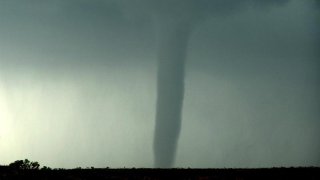
Shortly before 3 p.m. Saturday, an EF-1 tornado was registered in a town in Toulumne County, as confirmed by the National Weather Service (NWS), in Sacramento. The event was one of 11 tornadoes that occur annually on average in California.
Tornadoes in the Golden State are somewhat rare, and when they do occur -- like the small tornado Wednesday in Montebello -- they do not reach a higher risk category. NWS data indicates the first recorded tornado in the state was a F-1 tornado that touched down on May 17, 1949, 10 miles northwest of Fresno County.
The so-called Enhanced Fujita (EF) scale measures the damage caused by tornadoes, in which various indicators are used to finally evaluate the category and approximate wind speed. The scale was adopted in 2007 and was a revision from the original Fujita Scale.
| Category | Velocity | |
| Weak | EF-0 | Between 65 mph and 85 mph. |
| Weak | EF-1 | Between 86 mph and 110 mph. |
| Strong | EF-2 | Between 111 mph and 135 mph. |
| Strong | EF-3 | Between 136 mph and 165 mph. |
| Violent | EF-4 | Between 166 mph and 200 mph. |
| Violent | EF-5 | Over 200 mph. |
Get top local stories in Southern California delivered to you every morning. Sign up for NBC LA's News Headlines newsletter.
According to the NWS, tornadoes in California occur mainly in the spring and fall, and their magnitudes usually do not exceed EF-3 strength, that is, 165 mph. The NWS is the only federal agency with the authority to issue tornado warnings.
Although, on record, no tornado has exceeded level 2 to date, they are most likely in the area between Merced and Redding, in California's Central Valley.
Local
Get Los Angeles's latest local news on crime, entertainment, weather, schools, COVID, cost of living and more. Here's your go-to source for today's LA news.
Funnel clouds would be the first sign of a tornado trying to form.
A tornado watch is issued when tornadoes are possible in or near a specific watch area, it serves as a message to be prepared. It usually covers a big watch area that can expand through multiple counties or states. A tornado warning is issued when a tornado has been sighted or one has been indicated by a weather radar. Warnings notify people to take action because there is imminent danger.
Tornadoes can come in many different shapes and sizes, from a few feet to over a mile wide. According to experts, these factors do not necessarily imply the force of the tornado or its destructive capacity.
"Since tornadoes can change intensity rapidly, they should all be considered dangerous," the NWS website says.
How to prepare for a tornado?
According to the NWS, the best way to prepare for a tornado is to have a plan.
- Sign up for notifications: Stay up-to-date with community information from authorities. Alerts can be sent over the phone or some communities even have outdoor sirens.
- Be weather-ready: Regularly check weather forecasts to see if there are any tornado risks. Take precaution and have extra supplies before it becomes too late.
- Create a communications plan: Create a communications plan that include emergency meeting places,. Make sure each family member knows what to do or role they have in the case of an emergency. It's also best to speak with children about tornados and what they should do to remain safe.
- Practice your plan: Practice executing your plan so everyone knows what to do and there is an opportunity to make adjustments.
- Help a neighbor: If time allows help any nearby neighbors who might need extra assistance getting to safety.
What to do during a tornado?
- At your home: Go an interior room, closet, or a basement, away from any windows. If in an apartment complex, move to an interior hallway as low as possible. Shelter under a sturdy table, desk, or work bench.
- At your workplace or school: Stay away from windows. Do not go into large open rooms like gyms, auditoriums, or cafeterias.
- Outside: Try to find shelter as close as possible. Do not remain outside and do not go into any tents, sheds, storage units, or mobile homes.
- In a vehicle: Being inside of a vehicle during a tornado is not safe. Try to find nearby shelter. If you must remain in your vehicle get down on the floor and cover your heard.



